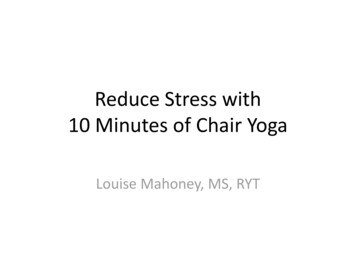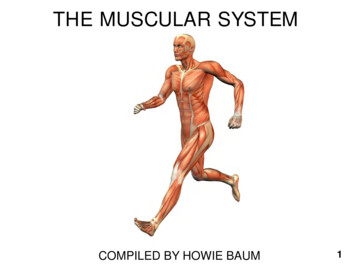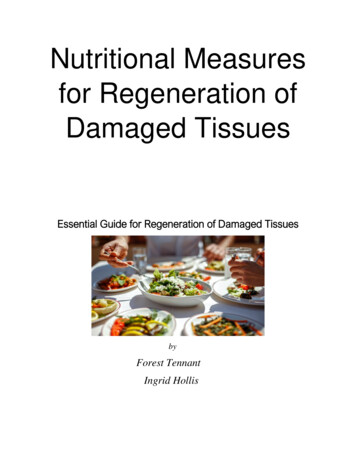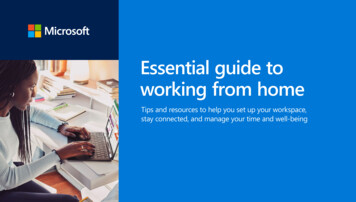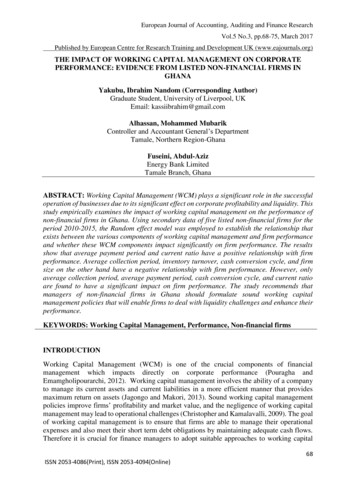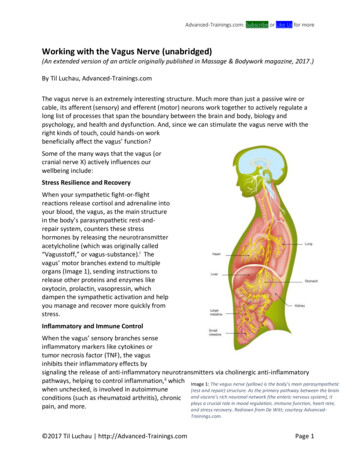
Transcription
Advanced-Trainings.com: Subscribe or Like Us for moreWorking with the Vagus Nerve (unabridged)(An extended version of an article originally published in Massage & Bodywork magazine, 2017.)By Til Luchau, Advanced-Trainings.comThe vagus nerve is an extremely interesting structure. Much more than just a passive wire orcable, its afferent (sensory) and efferent (motor) neurons work together to actively regulate along list of processes that span the boundary between the brain and body, biology andpsychology, and health and dysfunction. And, since we can stimulate the vagus nerve with theright kinds of touch, could hands-on workbeneficially affect the vagus’ function?Some of the many ways that the vagus (orcranial nerve X) actively influences ourwellbeing include:Stress Resilience and RecoveryWhen your sympathetic fight-or-flightreactions release cortisol and adrenaline intoyour blood, the vagus, as the main structurein the body’s parasympathetic rest-andrepair system, counters these stresshormones by releasing the neurotransmitteracetylcholine (which was originally called“Vagusstoff,” or vagus-substance).i Thevagus’ motor branches extend to multipleorgans (Image 1), sending instructions torelease other proteins and enzymes likeoxytocin, prolactin, vasopressin, whichdampen the sympathetic activation and helpyou manage and recover more quickly fromstress.Inflammatory and Immune ControlWhen the vagus’ sensory branches senseinflammatory markers like cytokines ortumor necrosis factor (TNF), the vagusinhibits their inflammatory effects bysignaling the release of anti-inflammatory neurotransmitters via cholinergic anti-inflammatorypathways, helping to control inflammation,ii which Image 1: The vagus nerve (yellow) is the body’s main parasympatheticwhen unchecked, is involved in autoimmune(rest and repair) structure. As the primary pathway between the brainconditions (such as rheumatoid arthritis), chronic and viscera’s rich neuronal network (the enteric nervous system), itplays a crucial role in mood regulation, immune function, heart rate,pain, and more.and stress-recovery. Redrawn from De Witt; courtesy AdvancedTrainings.com. 2017 Til Luchau http://Advanced-Trainings.comPage 1
Advanced-Trainings.com: Subscribe or Like Us for moreThe Viscera-Brain ConnectionThe vagus is the major communicator between the brain and the enteric nervous system—therich neurology of your viscera. Your guts, with more than 100 million neurons, 30neurotransmitters, and 95 percent of your body’s serotonin, send large quantities ofinformation to the brain via the vagus nerve’s afferent fibers; this sets the mood or emotionalbackdrop for your brain’s mental processesiii.Heart-Rate VariabilityWhile looking for a way to research vagal effects in the 1980’s, neuroscientist Stephen Porgesdeveloped vagal tone, or Heart Rate Variability (HRV), a measure of the vagus’ responsivenessand its power on the heart.iv Decreased HRV has since been associated with physical maladieslike heart disease and diabetes; as well as emotional conditions like strain, time pressure,vfeeling worried or anxious,vi depression, and PTSD.vii On the other hand, if you have a strongerHRV, you are more likely to recover quickly after injury, stress, or illness,viii and have betteremotional regulationix (though it’s not always clear which of these are the results of a strongervagal response, and which are its causes). Research into vagal HRV continues in many areas,and interestingly, several small studies over the last 30 years have shown that hands-onbodywork can have beneficial effects on vagal tone.xVagal StimulationVagal nerve stimulation (VNS) involves an implanted pacemaker-like device which electricallyexcites the vagus via an electrode wrapped around it in the neck. Though somewhat drasticsounding, VNS first received approval about 20 years ago in boththe US and Europe, and is used for treating a list of conditionsincluding epilepsy, headaches, and treatment-resistantdepression. VNS research continues for an even-broader range ofcomplaints, including anxiety disorders, Alzheimer's disease,migraines, fibromyalgia, obesity, and tinnitus.xi Though benefitshave been seen in some cases, not everyone responds to VNS;and there are clear risks (including infection, vocal hoarseness,breathing and swallowing problems), and the long-term sideeffects of VNS are unknown. xii But especially for those withdifficult and intractable conditions that haven’t responded toother treatments, VNS might offer welcome options.Of course, there are other, less invasive and less risky ways toelicit the vagus nerve’s beneficial effects. Documented methodsfor improving vagal function include controlled breathing(especially longer exhalation); meditation; moving and relaxingthe tongue, as well as singing, humming, and speaking (since the tongue and larynx areinnervated by the vagus); animated conversation (since facial expression also seems to have atwo-way relationship to vagal function);xiii improving gut health; exercise and rest; as especially,reducing sources of physical, mental, and social stress.Vagus nerve stimulation (VNS).Source: Alila MedicalMedia/Shutterstock 2017 Til Luchau http://Advanced-Trainings.comPage 2
Advanced-Trainings.com: Subscribe or Like Us for moreBut as hands-on practitioners, with our pragmatic perspective, our question is often, “That’s allinteresting, but how can I touch it, and in what way, that might help?”The Vagus in Your EarThe ear is the only place where the vagus nerve reaches the surface of the body (via theauricular branch of the vagus nerve, also known as Alderman's or Arnold's nerve, Image 2).Image 2: The ear is the only place the vagus nerve reaches the surface of the body. Green: vagus nerve(X): auricular branch. Violet: mandibular nerve (V3): auriculotemporal branch. Orange: lesser occipitalnerve (C2) and greater auricular nerve (C2, C3). White dots: facial nerve (VII): cutaneous fibers. CourtesyAdvanced-Trainings.com.Image 3: The auricular branch of the vagus nerve (dark green) and the ear structures it innervates (theconcha and external auditory meatus; transparent green). Courtesy Primal Pictures, used by permission. 2017 Til Luchau http://Advanced-Trainings.comPage 3
Advanced-Trainings.com: Subscribe or Like Us for moreIn fact, transcutaneous (via the skin) stimulation of thisparticular branch of the vagus is being studied as atreatment for numerous vagal-modulated conditions,and already has European clearance for treatingepilepsy, depression, and chronic pain.xivIn our Advanced Myofascial Techniques series atAdvanced-Trainings.com, we use several different eartechniques for addressing conditions like TMJ pain (thevagus nerve can be a powerful pain modulator via itsneuroimmune effects), as well as for migraine andheadache pain (see video link). Intriguingly, vagalstimulation has European clearance for treating clusterheadaches, migraines, hemicrania continua, andmedication overuse headache.xvThe Vagus Nerve TechniqueThe vagus’ auricular (ear) branch is made up of sensoryneurons, which means that sensation stimulated in thevagal-innervated parts of the ear (Image 2) will excitevagal nerve activity. Specifically, the ear’s concha (thedeepest bowl of the external ear, particularly its cymbaor upper recess), the external auditory meatus (the earcanal), and a small zone on the scalp just behind theear, all have vagal innervation. Since in most cases ouraim is also to calm and reassure the client’s nervoussystem, a gentle, confident, and sensitive touch (Image4) is usually most effective, with one study of babiesshowing that moderate pressure yielded greater vagalImage 4: The Vagus Nerve Technique involves stimulating sensation inthe vagus nerve’s auricular branches via moderate pressure, gentletraction, and active movement. Courtesy Advanced-Trainings.com. 2017 Til Luchau http://Advanced-Trainings.comVagus Nerve TechniquePurpose Increase vagal nerve activity throughgentle stimulation of sensation.Indications Migraines and other headaches TMJ pain and TMJD Stress, anxiousness, or sympatheticANS arousal May be helpful in a wide array ofconditions mediated by the vagusnerve, such as tinnitus, mood issues,immune function and autoimmuneconditions, epilepsy, pain, and others.Instructions Use gentle touch, pressure, or lighttraction on the ear’s concha (deepestbowl), ear canal, and the scalp justbehind the ears, to gently stimulatesensation in the ear’s vagus-innervatedareas. For migraine or TMJ pain, look for areasthat relieve pain, and for activemovements of the jaw, eyes, face thatevoke, relieve, or relate to the pain felt.Movement Cues “Let your exhale be even slower, fuller,and longer.” “Let your tongue rest in your mouth.” “Let’s hum a little tune andmeanwhile, let your neck and jaw stayrelaxed.” For migraines: “Look left and right withyour eyes.” For TMJ pain: “Gently, slide your jawaway from your ear.”For More Learning “TMJ” and “Migraines” in the AdvancedMyofascial Techniques series ofworkshops and video courses. Advanced Myofascial Techniques,Volume 2 Chapters 15, 18. (Handspring2016) Page 4
Advanced-Trainings.com: Subscribe or Like Us for moreImage 5: Gentle touch on the scalp’s vagusnerve-innervated zone, just behind theear, where the auricular branch emergesfrom the cranial vault through a small holein the temporal bone. Courtesy AdvancedTrainings.com.effects than light touch.xvi Since many people are not accustomed to having their ears includedin bodywork, be sure to ask permission first, and explain your purpose for proposing this work.Could manual therapy with the ears be used to evoke some of the vagus’ many beneficialeffects? Clearly, touch would not be expected to have the same effects as direct electricalstimulation, and though a few small studies have shown that hands-on work can measurablyaffect vagus tone,xvii others have had limited or mixed results,xviii and a definitive answer wouldrequire more investigation. But understanding more about the vagus can certainly stimulateour therapeutic imagination and creativity. And practitioners have long known that carefulwork with the ears, as well as relieving specific complaints like headaches and TMJ pain, can beextremely calming, perhaps because of the vagus’ power to soothe and relax both our body andmind.Want to know more about the vagus nerve? A few good links:Overview: Sarah Schwartz. (2016). Viva vagus: Wandering nerve could lead to range of therapies.Retrieved Sep 2017 from deringnerve-could-lead-range-therapiesVagal Nerve Stimulation: National Institute of Mental Health (2016). Brain Stimulation Therapies. Retrieved Sep2017 from aia Vince. (2015). Hacking the nervous system. Retrieved Sep 2017 s-systemNational Headache Foundation. (2016). Vagus Nerve Stimulation Suppresses BrainActivity that Leads to Aura, Headache. Retrieved Sep 2017 from 2017 Til Luchau http://Advanced-Trainings.comPage 5
Advanced-Trainings.com: Subscribe or Like Us for to-aura-headache/Heart Rate Variability:Til Luchau is the author of Advanced Myofascial Techniques (Handspring Publishing, 2016), aCertified Advanced Rolfer, and a member of the Advanced-Trainings.com faculty, which offersonline learning and in-person seminars throughout the USA and abroad. He welcomes questionsor comments via info@advanced-trainings.com and Advanced-Trainings.com’s Facebook page.NotesBennett, M.R. (2000). "The concept of transmitter receptors: 100 years on". Neuropharmacology. 39(4): 523–46.ii Oke SL, Tracey KJ. From CNI-1493 to the immunological homunculus: physiology of the inflammatoryreflex. J Leukoc Biol. 2008 Mar;83(3):512-7.iii Hadhazy, Adam. (2010). Think Twice: How the Gut's "Second Brain" Influences Mood and Well-Being.Scientific American. Feb 12, 2010 nd-brain/Accessed Sep 2017.iv Porges SW. (1992). Vagal Tone: A physiological marker of stress vulnerability. Pediatrics 90:498-504.v Nickel, P.; F. Nachreiner (2003). "Sensitivity and Diagnostics of the 0.1-Hz Component of Heart RateVariability as an Indicator of Mental Workload". Human Factors. 45 (4): 575–590.vi Jönsson, P. (2007). "Respiratory sinus arrhythmia as a function of state anxiety in healthy individuals".International Journal of Psycho-physiology. 63 (1): 48–54.vii Hagit, C.; et al. (1998). "Analysis of heart rate variability in posttraumatic stress disorder patients inresponse to a trauma-related reminder". Biological Psychiatry. 44 (10): 1054–1059.viii Conder, R. L., & Conder, A. A. (2014). Heart rate variability interventions for concussion andrehabilitation. Frontiers in Psychology, 5, 890. http://doi.org/10.3389/fpsyg.2014.00890ix Aubert AE, Seps B, Beckers F. Heart rate variability in athletes. Sports Med. 2003;33(12):889-919.x Cottingham, J. Porges, S. and Richmond, K. Shifts in Pelvic Inclination Angle and Parasympathetic ToneProduced by Rolfing Soft Tissue Manipulation. Physical Therapy, Vol. 68, No. 9, p.1364-70, September1988.xi Vagus nerve stimulation. (n.d.) In Wikipedia. Retrieved Sep 2017 fromhttps://en.wikipedia.org/wiki/vagus nerve stimulationxii National Institute of Mental Health (2016). Brain Stimulation Therapies. Retrieved Sep 2017 htmlxiii Gothard, K. M. (2014). The amygdalo-motor pathways and the control of facial expressions. Frontiersin Neuroscience, 8, 43.xiv Howland, R. H. (2014). Vagus Nerve Stimulation. Current Behavioral Neuroscience Reports, 1(2), 64–73; and: electroCore LLC. (n.d.) Migraine and Cluster Headache, raine.xvHowland, R. H. (2014). Ibid.xvi Field, T. et al. (2006). Moderate versus light pressure massage therapy leads to greater weight gain inpreterm infants, In Infant Behavior and Development, Volume 29, Issue 4, 2006, Pages 574-578.i 2017 Til Luchau http://Advanced-Trainings.comPage 6
Advanced-Trainings.com: Subscribe or Like Us for moreCottingham, J. Porges, S. and Richmond, K. Shifts in Pelvic Inclination Angle and Parasympathetic ToneProduced by Rolfing Soft Tissue Manipulation. Physical Therapy, Vol. 68, No. 9, p.1364-70, September1988. And, Cottingham, J. and J. Maitland (1997). “A Three Paradigm Treatment Model Using Soft TissueMobilization and Guided Movement-Awareness Techniques for a Patient with Chronic Low Back Pain: ACase Study,” Journal of Orthopedic Sports Physical Therapy 26(3):154-167.xviii Paschoal Mário Augusto. (2016) Influence of classic massage on cardiac autonomic modulation.Fisioter. mov. 2016 Sep; 29( 3 ): 487-496.xvii 2017 Til Luchau http://Advanced-Trainings.comPage 7
backdrop for your brain's mental processesiii. . While looking for a way to research vagal effects in the 1980's, neuroscientist Stephen Porges developed vagal tone, or Heart Rate Variability (HRV), a measure of the vagus' responsiveness and its power on the heart.iv Decreased HRV has since been associated with physical maladies

